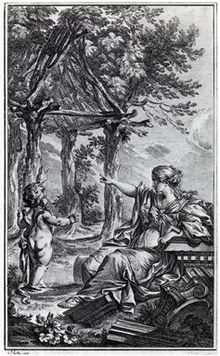Urhütte

The original hut is an architectural concept that goes back to Vitruvius and developed its effect on architectural theory , especially in the 18th century .
In Roman antiquity, Tugurium was initially understood to be a simple hut made of wood and clay with a roof made of reeds, tree bark or sod . It appears in the sources as poor dwelling or emergency shelter, or as typical of primitive peoples, e.g. B. the Dacians and Sarmatians , whose round huts are depicted on the Trajan's and Marcus columns .
Vitruvius describes the constructions used by various barbarian peoples, but then draws the arch and links these huts with the beginnings of technology, architecture and, last but not least, Roman history by pointing out that the Casa Romuli , a simple straw hut on the Palatine Hill , which was ascribed to Romulus , the mythical founder of Rome , was a construction of exactly this type.
The simple hut described by Vitruvius, as an idealized principle of the natural home, gained a far-reaching effect in the architectural theory of the 18th century as an original hut , especially with Marc-Antoine Laugier , in whom it was depicted on the frontispiece of the 2nd edition of his Essai sur l'Architecture , published in 1755 is, and in the succession for example with François Blondel and Nicolaus von Thaden up to Oswald Mathias Ungers .
literature
- Walter Hatto Groß : Tugurium. In: The Little Pauly (KlP). Volume 5, Stuttgart 1975, column 995.
- Christoph Höcker : Metzler Lexicon of Ancient Architecture. 2nd edition Metzler, Stuttgart 2008, ISBN 978-3-476-02294-3 . P. 262
- Joseph Rykwert: Adam's House in Paradise. The Urhütte from Antiquity to Le Corbusier , Berlin 2005.
- Marc-Antoine Laugier: The Manifesto of Classicism. Verlag für Architektur Artemis, Zurich 1989, ISBN 3-7608-8124-6
Individual evidence
- ↑ Marcus Terentius Varro Rerum Rusticarum de Agri Cultura 3.1.3
- ^ Virgil Eclogae 1.68
- ↑ Pliny the Elder Naturalis historia 16.35
- ↑ Vitruv de architectura 2.1
- ↑ Vitruv de architectura 2.1.5: Item in Capitolio commonefacere potest et significare mores vetustatis Romuli casa et in arce sacrorum stramentis tecta.